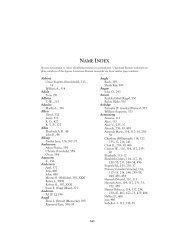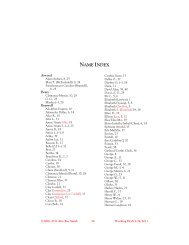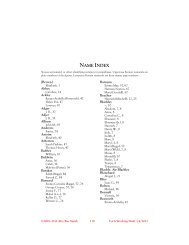Digital Filtering Tutorial, Part II - Alvy Ray Smith Homepage
Digital Filtering Tutorial, Part II - Alvy Ray Smith Homepage
Digital Filtering Tutorial, Part II - Alvy Ray Smith Homepage
Create successful ePaper yourself
Turn your PDF publications into a flip-book with our unique Google optimized e-Paper software.
<strong>Digital</strong> <strong>Filtering</strong> <strong>Tutorial</strong>, <strong>Part</strong> <strong>II</strong> 3<br />
the B-spline (beta) cubic spline which are familiar to computer graphicists from<br />
other contexts. The support-8 filters are all obtained from the sinc function from<br />
a window (function). Windowing is accomplished by multiplying a window function<br />
times the sinc function. In all cases the filters are FIR (Finite Impulse Response)<br />
filters [3, 4].<br />
The most simple window is just a box function of unit height and support 8.<br />
This is called the rectangular or Fourier window, and windowing in this case is<br />
simple truncation. The next higher order window is the triangular or Bartlett<br />
window. In the figures are shown several more sophisticated windows named<br />
typically for their discoverers.<br />
Since the ideal filter is the sinc, it must be the case that windowing causes a<br />
non-ideal filter. A feeling for the error introduced by windowing may be got<br />
from considering a step function—ie, a hard edge in a picture. Convolving the<br />
step with a truncated sinc introduces the so-called Gibbs phenomenon, undershoot<br />
before the edge, overshoot after it, and ripples in both places. Furthermore<br />
the edge is no longer straight up and down but is skewed slightly. So the hard<br />
end is softened slightly and appears to “ring” from the ripples on either side. A<br />
successful window function minimizes these annoying artifacts. As can be seen<br />
from Figure WINDOW, the more sophisticated the window, the smaller are the<br />
ripples (the lower is the “peak amplitude of the side lobe”) but the softer is the<br />
edge (“transition width of main lobe”).<br />
Figure WINDOW gives the formulas for Rectangular, Bartlett, Hamming,<br />
Hanning, and Blackman windows. The Kaiser window is a family of windows<br />
where the parameter














